Physical Address
304 North Cardinal St.
Dorchester Center, MA 02124
A web-like lesion at the iliocaval junction was described by McMurrich, a Canadian physician, in 1908. Recognition of the lesion now commonly known as May–Thurner syndrome (MTS), or iliac compression syndrome, evoked a series of controversies from the start. Initial debate involved the origin of the lesion: was it ontogenic or acquired? Based upon the rarity of the lesion in embryos and infants, an acquired etiology is now generally accepted, although a few lesions occur at known fusion planes and could be classified as ontogenic. , Since neovascularization is absent, post-thrombotic etiology is not likely. May and Thurner proposed that the lesions, which can range from increased wall thickness to intraluminal membranes, webs, and fibrous strands, result from the trauma of the repeated pulsations of the closely related artery. The name “iliac compression syndrome” is incomplete as compression is but one element of a complex lesion.
Later controversies arose concerning the high prevalence of MTS in the general population in silent form. Cockett reported that the lesion can be highly symptomatic in a select group, often young women of child-bearing age, with preferential involvement of the left lower extremity. In some patients, the lesion appeared to precipitate deep venous thrombosis of the extremity. Lea Thomas, a radiologist, developed specialized techniques to visualize the lesions with contrast, while recognizing that venographic sensitivity was only about 50%. Modern imaging techniques have confirmed that iliac vein compression posterior to the crossing right common iliac artery is present in as much as two-thirds of the general population. Recent use of intravascular ultrasound (IVUS) has shown the lesion to be present at more diverse locations in the pelvic venous anatomy ( Fig. 161.1 ), and that it affects a much broader demographic than the narrow band recognized by Cockett and colleagues. IVUS has a sensitivity of >90% for the lesion. Most lesions are silent, but symptoms ranging from swelling to venous ulcerations may be present. The lesion is best viewed as a permissive pathology, precipitating symptoms when a secondary insult to the limb, such as trauma, infection, or deep venous thrombosis (DVT) is superimposed. Post-thrombotic iliac vein stenoses resulting from DVT, either precipitated by a May–Thurner type of lesion or occurring de novo , are increasingly recognized. Specific relief of symptoms after percutaneous stent placement has largely silenced earlier critics who argued that the obstructive lesion, even when associated with collaterals, is a “natural anatomic variant” not requiring specific correction. Percutaneous iliac vein stenting has rendered earlier veno-venous bypass techniques all but obsolete, and these techniques are now reserved only for stent failures. IVUS technology has also exposed venous obstruction at the iliac level as a major cause of chronic venous disease (CVD). , The safety and efficacy of venous stenting have dramatically broadened the spectrum of CVD patients who can undergo treatment for this disease with clear clinical improvement. This represents a major treatment paradigm change. An unexpected finding in recent stent experience is the observation that patients with combined obstruction and reflux appear to benefit clinically even if the associated reflux remains untreated.
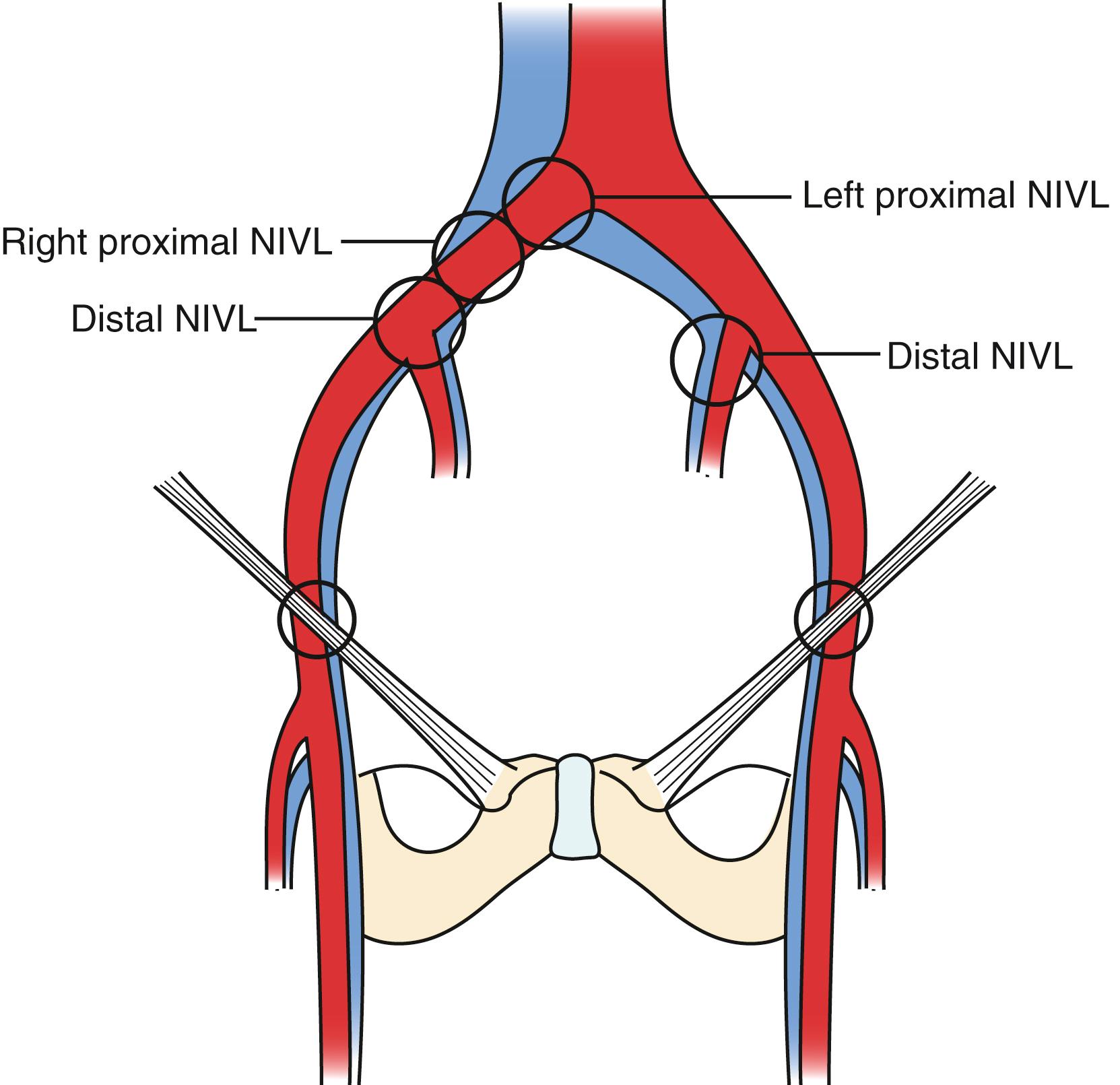
Two major types of iliocaval venous obstruction are recognized, nonthrombotic iliac vein lesions (NIVL), synonymous with MTS, and post-thrombotic iliac vein stenosis (PTS) resulting from a prior episode of DVT. The relative incidence in major centers is roughly 50/50 but trending higher in favor of the post-thrombotic variety because of improved diagnosis of iliac vein DVT with modern imaging modalities. About 10% of cases are of the mixed type, as NIVL can precipitate thrombosis, and thrombus tends to add fibrosis to compression points in the vein during organization. NIVL lesions are typically sub-segmental and focal, occurring in areas where compression by the overlying artery or ligament occurs ( Fig. 161.1 ). PTS lesions are longer, involving one or more vein segments, with focal elements. A special form of long diffuse stenosis caused by a post-thrombotic fibrous envelope surrounding the vein was first recognized by Rokitansky in autopsy studies. Milder forms of this type may not be recognizable in venograms without luminal measurements ( Fig. 161.2 ). A focal lesion occurring in association with a Rokitansky stenosis will be underestimated as the adjacent reference segment for calculation of the stenosis is not normal but stenotic.
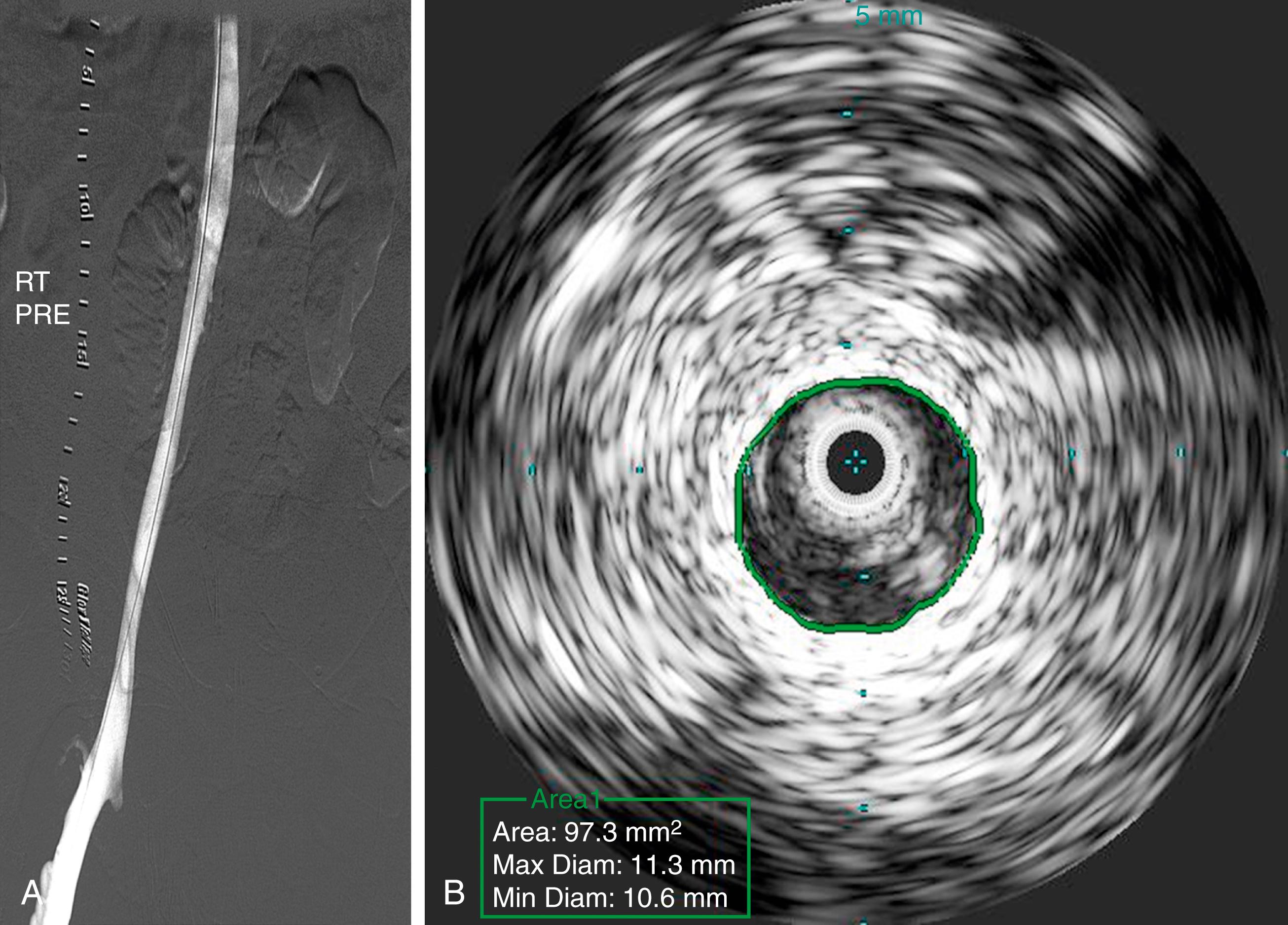
The majority of limbs with iliac vein obstruction will also have reflux below the inguinal ligament, resulting in peripheral venous hypertension. Both the obstructive and reflux pathologies cause microvascular injury, which is sustained by the peripheral venous hypertension. Recent studies have shown that central venous obstruction is more associated with elevated supine venous pressure while reflux is more associated with elevated venous pressures in the upright position. Ambulatory venous pressure which rises with increasing CEAP clinical class also worsens with increasing reflux and is less associated with obstruction. ,
Venous collateralization is poorly understood. In many venous territories, alternative pathways already exist. They normally remain dormant as flow preferentially takes the course of the lower resistance main pathway. When the main channel is stenosed or occluded and the venous pressure rises, flow is diverted through these alternative routes. When the axial stenosis is stented, flow once again takes the lower resistance pathway and the collaterals “disappear.” Venographic collaterals can be demonstrated in about 30% of iliac vein stenoses. , Because of the geometric factor (r /L) in the Poiseuille equation, an exponential number of collaterals are needed to equal the conductance of the normal iliac vein. For example, 256 collaterals, each 4 mm in size, are required to equal the conductance of a 16-mm common iliac vein. For this reason, it is rare for iliac vein lesions to be fully compensated by adequate collateralization. The exponential power of the geometric factor plays a role in venous resistance. The magnitude of its effects can be surprising. For example, a luminal stenosis of a mere 12% in the common iliac vein (16 mm to 14 mm) will nearly double the resistance, and hence, the pressure with the same flow.
Using isotope lymphangiography, lymphatic dysfunction can be demonstrated in ≈30% of limbs with CVD. , The injury occurs at the pre-collector level, presumably in association with the microcirculatory injury of CVD. Normalization of these scintigraphic abnormalities occurs in about 25% of limbs following iliac stenting ( Fig. 161.3 ).
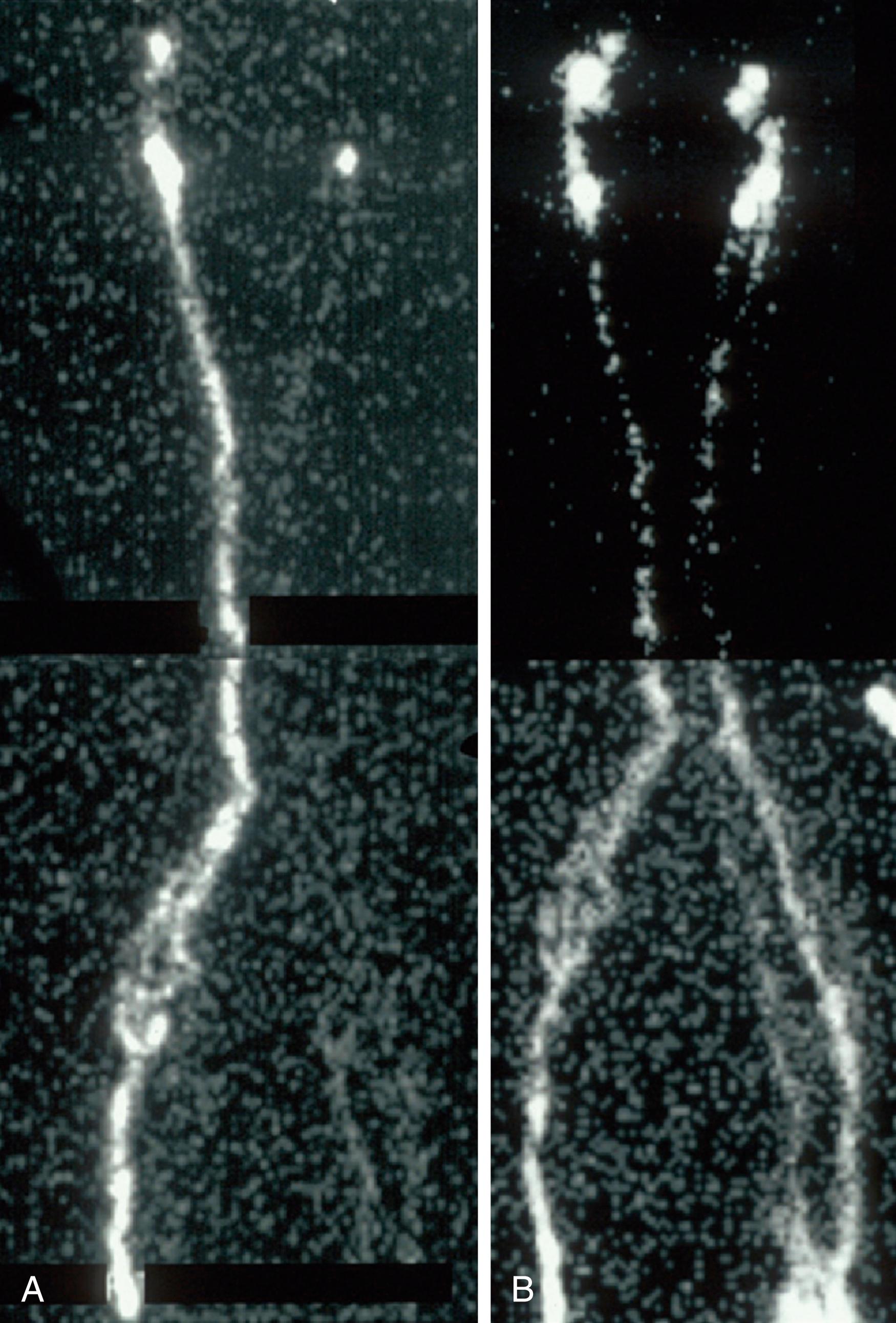
CVD in general is a nonlethal disease and loss of limb is a rarity. There is no role for prophylactic treatment of silent lesions. If symptoms resulting from iliocaval stenosis or occlusion are present, conservative treatment with compression is the initial treatment modality. This modality will fail in 50% or more patients because of inefficacy or, more often, noncompliance with compression regimens. The nature and cause of noncompliance is poorly understood. Intensive monitoring, education, and supervision have had no effect on the problem. , Iliac vein stenting may be carefully considered after failure of conservative treatment. Patients should be advised that this is not a “circulation problem” of the type that affects arteries, but a disease that usually manifests with only quality-of-life issues. Patients are often relieved by this information alone and are then able to make an informed decision regarding intervention.
In general, only patients with CEAP classes 3 to 6 are candidates for correction of iliocaval stenosis. Lesser clinical classes can occasionally be considered if they are thought to have venous claudication or the “venous hypertension syndrome.” Patients with venous hypertension syndrome have diffuse limb pain (not to be confused with local pain over varices) relieved by elevation of the limb and compression stockings. Some patients have learned that ambulation can provide pain relief due to lowering of the venous pressure by calf pump action. Atypical pain syndromes include venous claudication (particularly when climbing stairs), nocturnal leg cramps, restless legs, and dull, diffuse, achy limb pain at night even with the leg elevated. Lifestyle limitations and sleep deprivation from these atypical pain syndromes are appropriate indications for corrective intervention. Pain severity should be assessed by the visual analog scale (VAS). Venous clinical severity score (VCSS) is the current standard for complete clinical assessment (see Ch. 20 , Clinical Evaluation of the Venous and Lymphatic Systems).
Special patient subsets who may benefit from stent correction of iliocaval venous stenosis include geriatric patients who cannot self-apply compression due to arthritis or frailty, obese patients with severe venous manifestations who are not candidates for weight reduction surgery, patients with recurrent cellulitis of the limb secondary to the obstructive lesions, and cases of acute iliac vein thrombosis caused by an underlying stenosis. Lysis of the acute thrombus will initially be required in combined acute/chronic lesions. It is best to wait for at least 2 months after lysis and pursue stenting selectively in patients who continue to remain symptomatic or have recurrence of symptoms following thrombolysis.
In another special category are limbs with swelling diagnosed as lymphedema. Too often, this diagnosis is based only on clinical impression without the benefit of isotope lymphangiography. “Classic” clinical features of lymphedema, such as dorsal foot hump, squaring of toes, and Stemmer sign, can be present in venous swelling as well, with or without associated lymphatic damage/dysfunction. A recent study that evaluated the diagnostic accuracy of clinical signs in comparison to lymphoscintigraphy found clinical signs of lymphedema to be unreliable in making a correct diagnosis of lymphedema in a third of patients. Conversely, in lymphoscintigraphy-confirmed lymphedema, only 17% had positive clinical signs. The study found venous obstruction as the most common cause of clinical signs in patients without lymphedema. Considering the huge prevalence of CVD in western populations and the high incidence of associated lymphatic abnormalities, it is likely that lymphedema associated with CVD (“venous lymphedema” or phlebolymphedema) is the most common type of secondary lymphedema in the Unites States, with a prevalence far exceeding either primary lymphedema or other secondary causes.
A diagnosis of lymphedema may consign the patient to lifelong, often ineffective conservative therapy. It is recommended that a correctible iliac vein stenosis be ruled out in individuals before a diagnosis of lymphedema is established for treatment purposes. After stent correction of a stenosis discovered by this approach, improvement in swelling can be expected, although to a lesser degree than in obstructed limbs without lymphatic abnormalities (see Fig. 161.3 ).
Associated reflux is often present in patients diagnosed with iliac vein obstruction. If the reflux is in the superficial system, saphenous ablation can be performed before iliac vein stenting, or it can be accomplished concurrently. Patients with deep reflux should undergo iliac vein stenting first, as good results can be anticipated despite the residual reflux. Deep reflux corrective procedures which currently require complex open techniques are reserved for the salvage of nonresponders to initial stenting.
Venography has been the main imaging modality to diagnose iliac vein lesions. Transfemoral injection of contrast is required as adequate opacification of pelvic venous anatomy is often not obtained by pedal injection. Because iliac vein lesions are manifested as compression in the coronal (distal lesion) or the sagittal plane (proximal lesion), single plane views can be misleading ( Fig. 161.4 ). However, subtle signs are often present to alert the astute observer ( Fig. 161.5 ).
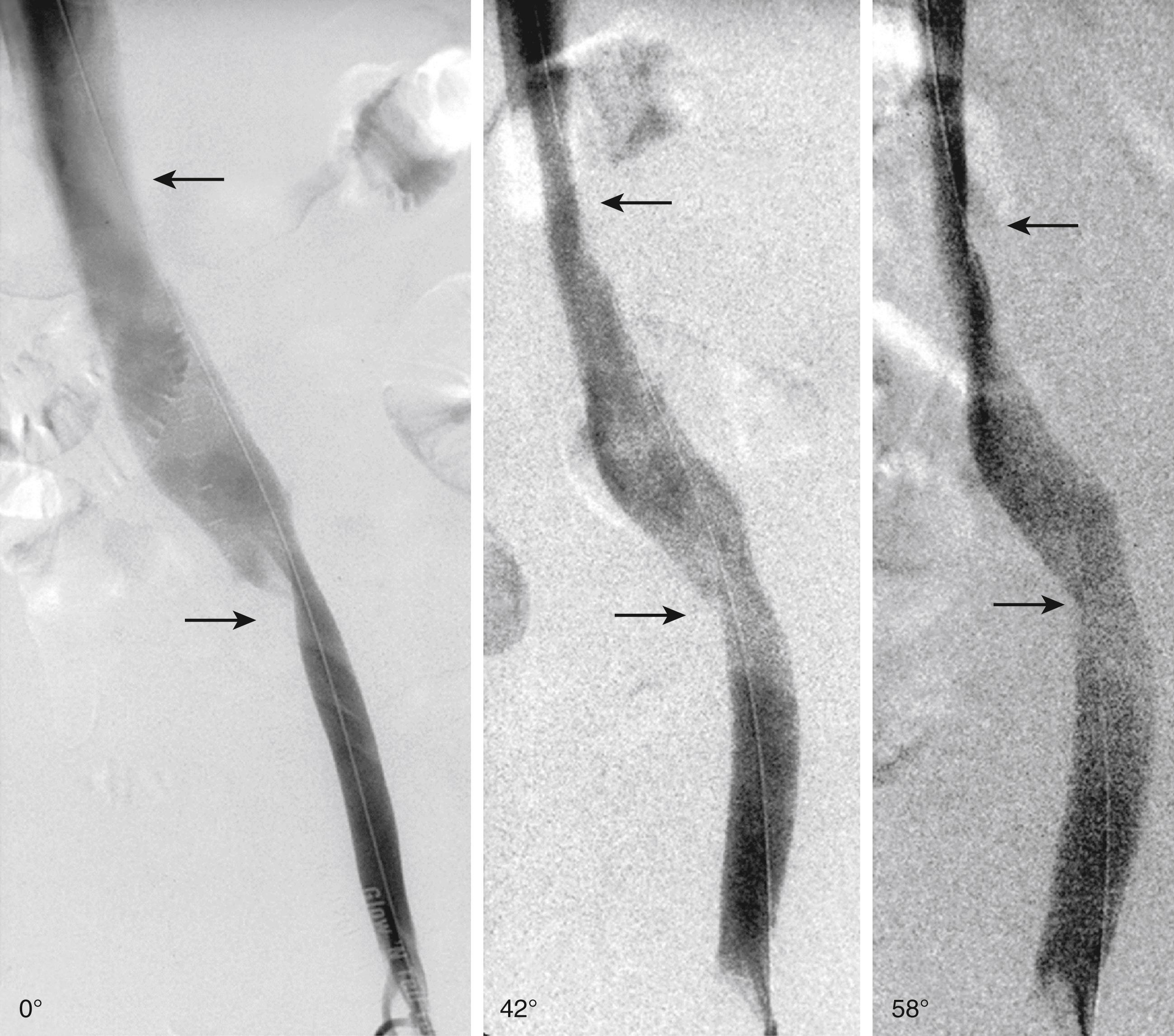
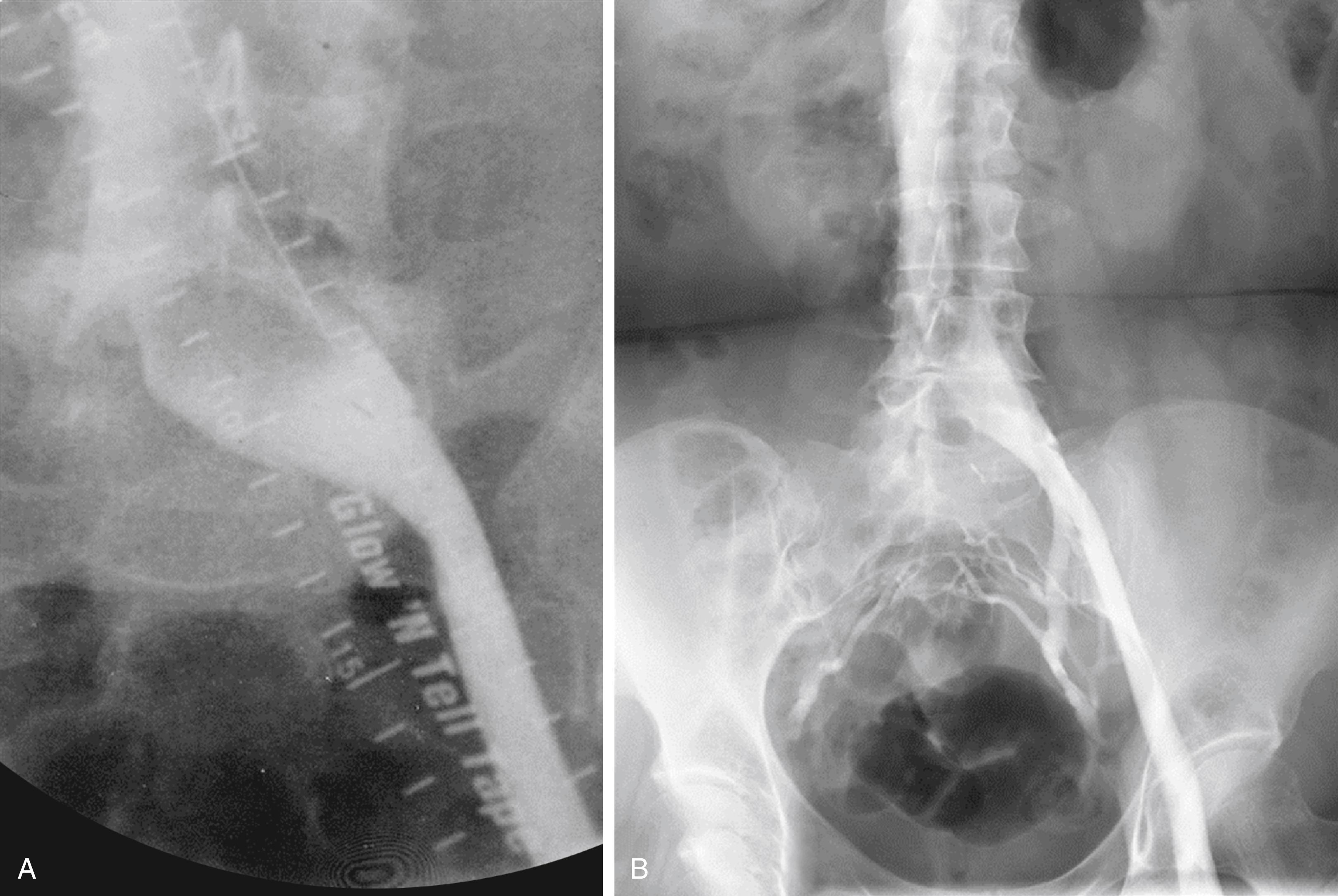
In a blinded comparison of IVUS and transfemoral venography in 155 limbs at our institution, the presence of a stenosis in the iliofemoral segments was altogether missed by venography in 19%. Among those lesions visible with contrast, the degree of stenosis was significantly underestimated compared to IVUS ( P < 0.001). In addition, the level of the iliac confluence as determined by venography varied by as much as one vertebral body length compared to that identified using IVUS. The ideal upper and lower landing zones determined by venography agreed with IVUS guidance in only 15% and 26% of limbs, respectively. Therefore, IVUS guidance during stent placement is preferred. These procedural elements are crucial for technical success and outcome.
Imaging techniques (computed tomography venogram, magnetic resonance venogram, or duplex ultrasound) can be more definitive than venography for diagnosis, as lumen size at stenotic points can be measured by the intrinsic scale, which is not possible with venography. Recent studies have confirmed the ability of computed tomography venogram in diagnosing iliocaval venous obstruction by comparing it to IVUS. , At present, we consider IVUS the gold standard in the morphologic diagnosis of iliac vein lesions.
A mid-thigh ipsilateral femoral vein access under ultrasound guidance is preferred. Access at superficial locations over bony points, as in arterial practice, is not necessary. Low venous pressure facilitates even deep access with few hematomas or other complications. A large sheath, typically 11 F, is preferred for easy manipulation of inserted devices. The mid-thigh access allows enough room for the sheath to deploy stents below the inguinal ligament if needed. This approach has the advantages of the supine position, short distance to the lesion, and antegrade manipulation. Popliteal and internal jugular access are somewhat inferior, but can be used as backup sites. An optional on-table venogram may be performed for diagnostic and road-mapping purposes. The procedure can be performed solely with fluoroscopy and IVUS control without using contrast in the event of contrast allergy or renal dysfunction. IVUS examinations of the inferior vena cava (IVC), common iliac vein (CIV), external iliac vein (EIV), and common femoral vein (CFV) are carried out to identify lesions and appropriate landing sites. IVUS planimetry is used to measure areas. The degree of stenosis is best calculated using the expected normal area for the location ( Table 161.1 ). Using the adjacent or contralateral lumen as a reference may result in underestimation of the stenosis; long diffuse narrowing of the lumen is present in an estimated 20% either alone or in association with focal stenosis. It is important to keep in mind that venous hypertension can result with luminal area stenosis <50% secondary to changes in compliance. In this regard it is imperative not to use a predetermined stenosis cutoff to determine stenting. Patients with disabling symptoms merit stenting even if the degree of stenosis is less than 50%. Predilation using large-caliber (16 to 18 mm) high-pressure balloons (14 to 16 atm) is routine. Because of the fibrous nature of iliac vein lesions, angioplasty alone is seldom effective as recoil is the rule. Large-caliber stents approximating the normal size of the iliofemoral segments should be used. The use of undersized stents is among the most common causes of iatrogenic stenosis with persistent symptoms ( Fig. 161.6 ).
| Vein | Diameter (mm) | Luminal Area (mm 2 ) |
|---|---|---|
| CFV | 12 | 125 |
| EIV | 14 | 150 |
| CIV | 16 | 200 |
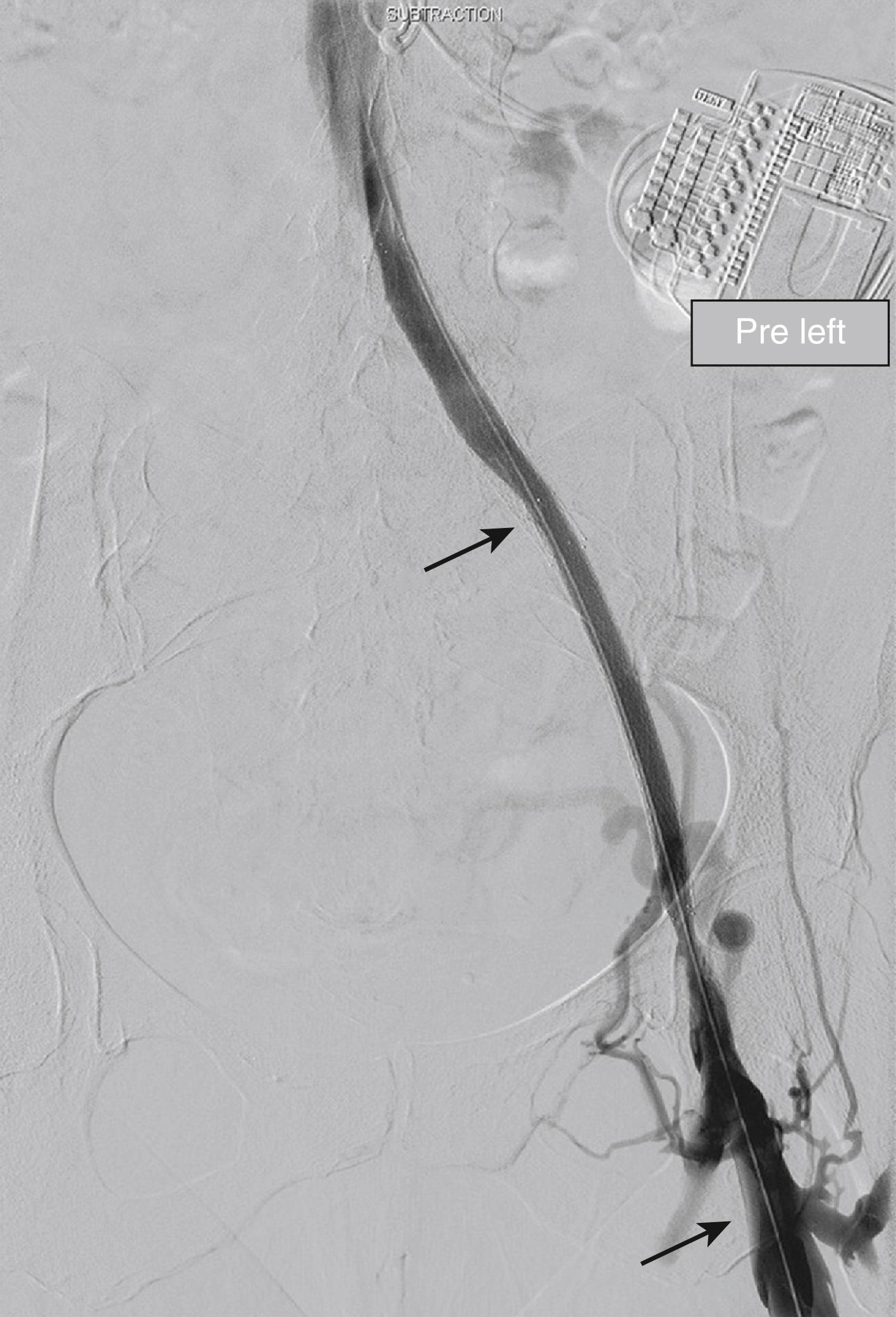
Treating the entire diseased segment or lesion in continuity with landing sites clear of disease is essential for successful outcomes. Skipping short segments of apparently normal vein is a source of potential recurrence. It appears that metal load is a lesser cause of stent thrombosis than uncovered lesions. From this perspective, a philosophy of liberal stent coverage rather than one of limited use should govern. Most limbs with post-thrombotic disease will require extension of the stent below the inguinal ligament into the common femoral vein. The stent end should remain above the orifice of the deep femoral vein, which provides adequate inflow in most instances to sustain the stent. Occasionally, the stent can be delivered into the deep femoral vein (via jugular, popliteal, or direct deep femoral access) if its ostium is involved in the post-thrombotic process. Stent fractures and erosions have been rare with stents crossing the joint crease, unlike arterial applications. Since the proximal lesion at the iliocaval confluence is spiral, incomplete stent coverage in this area is a common cause of residual symptoms. This tends to occur in procedures that are totally reliant on venographic control without the use of IVUS. The best upper and lower landing sites are chosen on IVUS views using the vertebral bodies and the femoral head as fluoroscopic markers. Extension of the iliac stent for a few centimeters into the IVC is generally required to traverse the proximal lesion in its entirety when Wallstents are exclusively used. An 18- or 20-mm stent dilated with 16- and 18-mm balloons, respectively, will accommodate most adults and provide a 2-mm reserve for extra dilation later if required. A Z-stent may be used proximally (within the Wallstent) for added radial strength under the artery, and to minimize jailing of the contralateral iliac outflow ( Fig. 161.7 ). The IVC Z-stent extension greatly simplifies bilateral simultaneous or sequential stenting by eliminating the need for difficult fenestration techniques to reconstruct the iliac confluence. A significant reduction in contralateral DVT has been observed with the Z-stent extension compared to the Wallstent extension. Use of appropriate size dedicated venous stents can be used in the same manner as Wallstent–Z-stent combination with regards to extension across the iliocaval confluence. Other principles of femoroiliocaval stenting discussed above should be borne in mind when utilizing the new stents. Dedicated venous stents currently approved for use by the FDA include Vici (Boston Scientific, Marlborough, MA) and Venovo (Bard, Tempe, AZ) ( Fig. 161.8 ). Stenting the iliocaval confluence, particularly when there is bilateral disease, is an unsolved problem. An ideal stent for the confluence is yet to be developed.
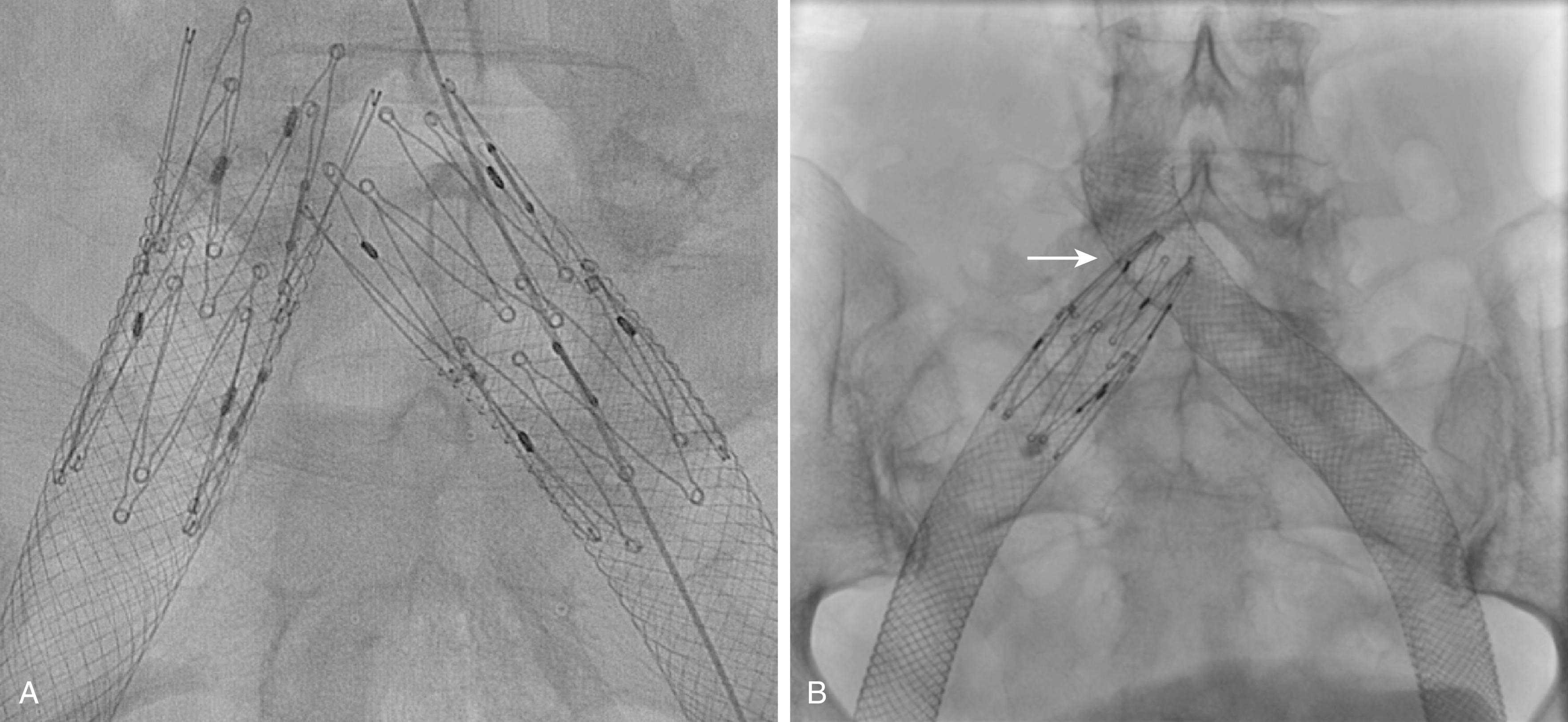
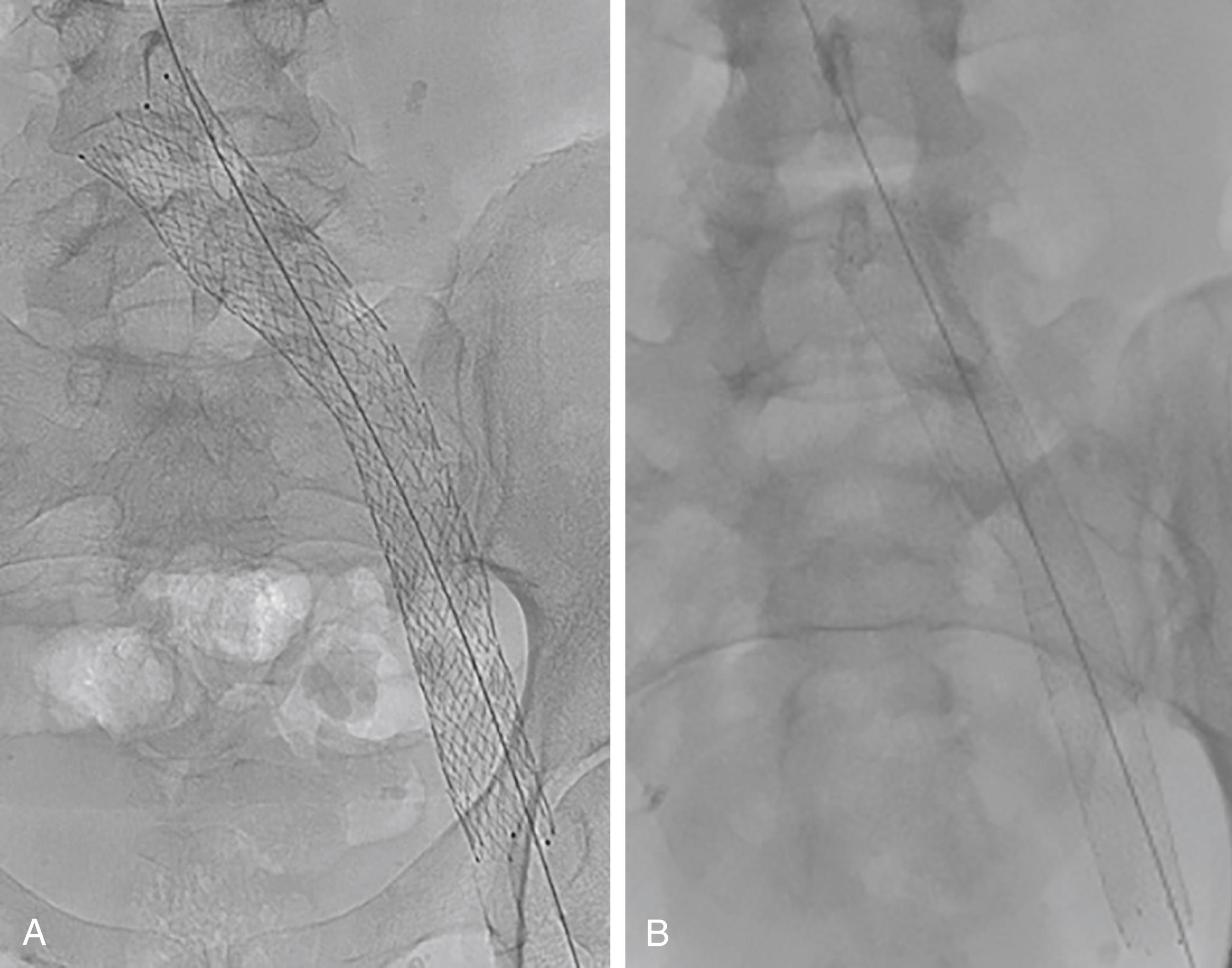
Post-dilation is carried out after stent deployment. IVUS planimetry is used to confirm that the stenosis has been corrected to achieve the recommended caliber shown in Table 161.1 . If not, a larger balloon up to the maximum-rated diameter of the stent is used to achieve the desired caliber. A completion venogram is performed to confirm patency and flow. The sheath is withdrawn slowly under ultrasound view until the tip exits the vein. A slight to-and-fro movement of the sheath confirms that it is outside the vein. A plug of Surgicel Fibrillar (Ethicon, Somerville, NJ) is loaded into the cylindrical plastic guard of the Seldinger needle. Using the obturator with the tip cut off, the hemostatic plug can be pushed into the sheath and delivered over the venotomy site before complete withdrawal of the sheath.
Recent data demonstrates that patients with bilateral chronic venous insufficiency symptoms should undergo initial stenting of only the more symptomatic leg, since only 5% of patients with bilateral symptoms end up requiring stenting of the contralateral side. This is possibly from loss of collateral cross-pelvic channels (that cause overloading) post stenting of the ipsilateral side.
Once the province of complex open surgical procedures, chronic total occlusion (CTO) lesions have been found to be surprisingly amenable to percutaneous recanalization in an outpatient setting. Procedure success rates are in the range of about 85% for both iliac and IVC lesions. , Percutaneous recanalization of extensive occlusions involving both iliac veins and the IVC up to the right atrium have been reported in large case series ( Fig. 161.9 ). Most of these will have chronically occluded renal and hepatic drainage with alternate outflow already established. Few hepatic or renal complications after successful recanalization have been reported.
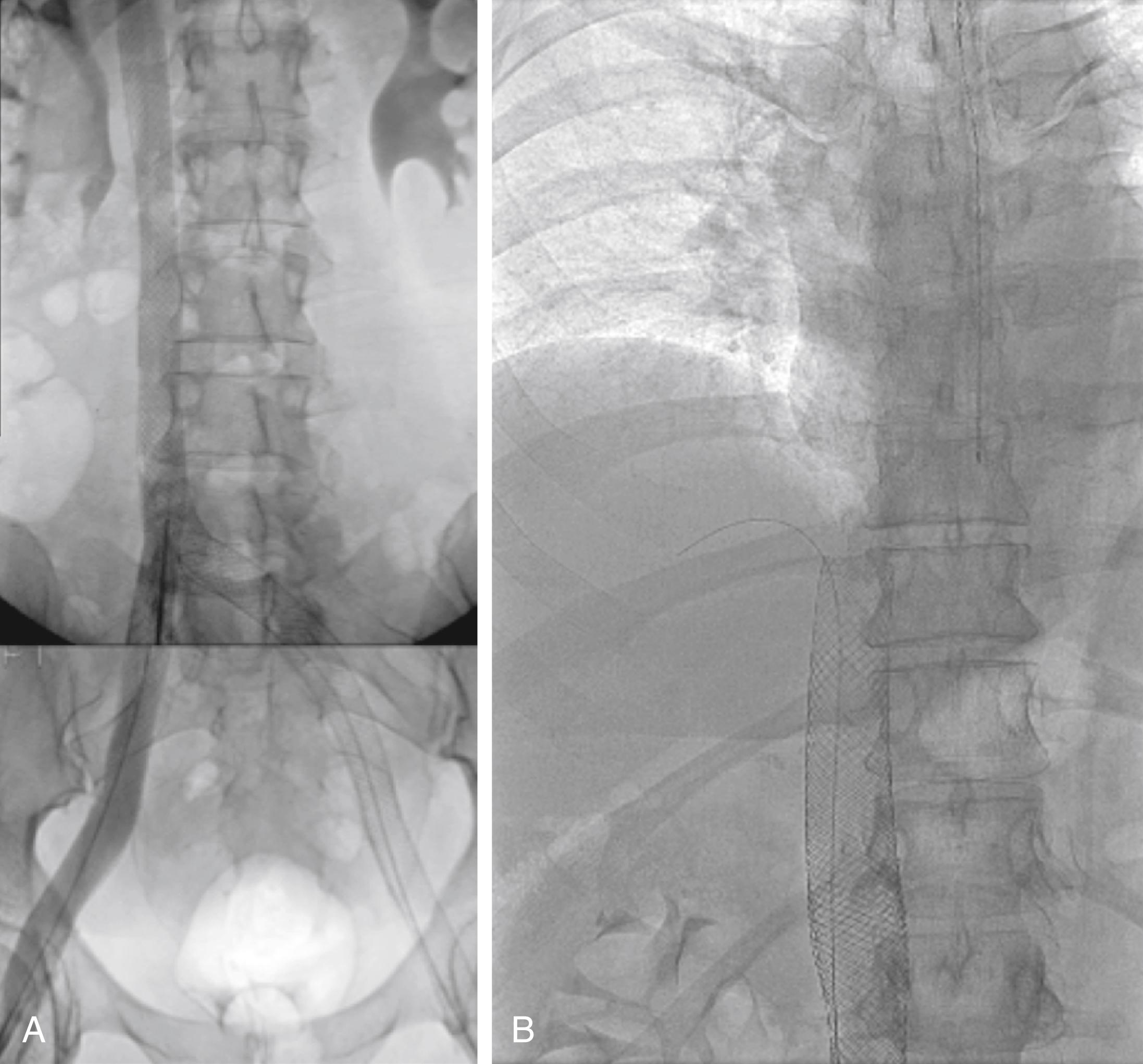
The recanalization process involves blind threading of a Glidewire through the trabeculated vein. Passage with the tip of the Glidewire rather than a loop is more often successful. Unlike in arterial CTO, no subendothelial or deeper dissection is performed. Venography, at least in the initial stages, is necessary to define the anatomy and provide a road map. Some CTO lesions that appear daunting on venography can be traversed with surprising ease. This is because contrast may not reach loosely trabeculated segments (often appearing as a “blush”) above short segments of more densely trabeculated vein. The use of angled-tip guiding catheters is standard. Specialized catheters for CTO crossing are helpful. The recanalization course should conform to the normal anatomic course of the occluded vessel. Off-course passage into collaterals or perforations is easily recognized. Because of the low venous pressure and dense fibrous cover over CTO veins, free hemorrhage is rare. In case of perforation, the wire can simply be withdrawn and redirected without aborting the procedure. The passage of the wire into the vertebral canal through collaterals is a hazard if not recognized before balloon dilation. Since the abdominal IVC lies to the right of the vertebral column, passage of the wire in the midline is a clue to vertebral canal entry ( Fig. 161.10 ). This can be checked by oblique or lateral fluoroscopic views. Once the entire CTO lesion is traversed, proper reentry into the open upper IVC or right atrium should be confirmed by venography or IVUS. Occasionally the wire passage may require predilation to allow passage of the 8.5-F IVUS catheter. Normally, the wire tract can be dilated to the desired caliber in a single pass. Stepwise dilation is not necessary as rupture/hemorrhage is very rare. We recommend dilation to 24, 18, 16, and 14 mm for IVC, CIV, EIV, and CFV segments, respectively. To conserve supplies we use 18-mm balloons for all iliofemoral segments and have not encountered problems. Wallstents of corresponding size are then deployed. Small leaks and contrast extravasations are self-limiting once the low-resistance main pathway has been established by stent placement. Completion venography and IVUS planimetry are essential to ensure that a recanalized passage of adequate caliber without conduit defects has been established.
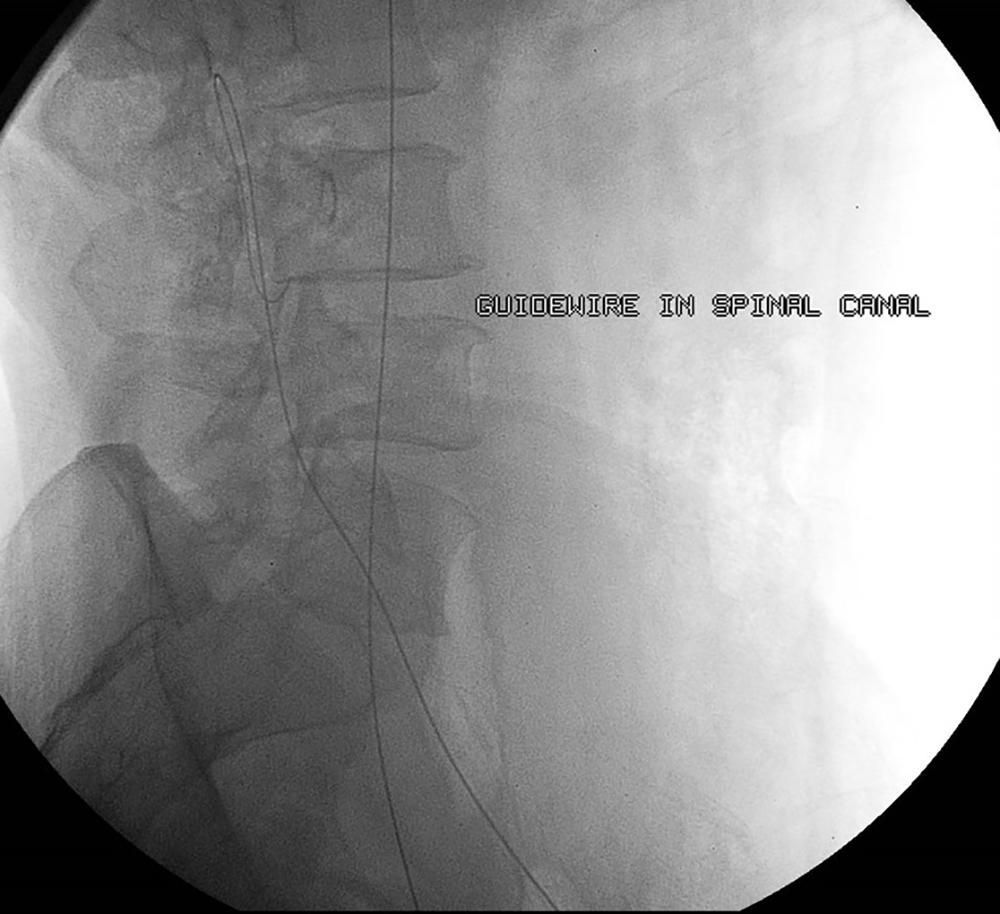
Inadequate inflow into stents is both a short-term and long-term threat to stent viability. There is presently no reliable way to assess inflow. Some stents with rapid washout of contrast have occluded, and others with sluggish flow have surprisingly remained patent. Intraoperative flow may be affected by extraneous factors, including the presence of the sheath obstructing inflow. Preoperative venographic assessments have not been reliable as more inflow channels become invisible once a low-resistance channel has been established by the stent. In extreme cases in which all the major named inflow pathways have become occluded and only multiple “twiggy” collaterals provide inflow, a temporary A–V fistula may be considered.
Become a Clinical Tree membership for Full access and enjoy Unlimited articles
If you are a member. Log in here